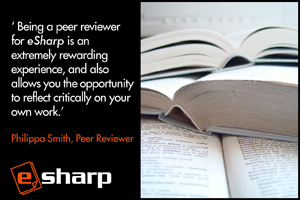Why peer review for eSharp?
Why peer review for eSharp?
 Peer reviewing is an important task which will be expected from everyone a some point during a career in academia, and reviewing for eSharp is an excellent way to gain the skills necessary to complete an academic review.
Peer reviewing is an important task which will be expected from everyone a some point during a career in academia, and reviewing for eSharp is an excellent way to gain the skills necessary to complete an academic review.
All submissions to eSharp are subject to a thorough peer review process, both to ensure the quality of the publication and to help students develop their research and writing skills. Acceptance of all submissions to eSharp is conditional upon the comments of our reviewers, and each submission is subject to multiple reviews to ensure this peer review element is as robust as possible. Peer reviewing is crucial to the success of eSharp - without our peer reviewers, continuing to publish issues which showcase only the best in postgraduate research would be impossible.
Any postgraduate student in the Arts, Humanities, Social Sciences or Education as well as post-doctoral students within the first year of gaining their PhD are welcome to review for eSharp.
What does peer reviewing involve?
What does peer reviewing involve?
If an article is submitted which matches your research interests, you will be sent a copy of the article to review along with eSharp's Peer Review Pack and Style Guide, allowing you to get the most out of the experience and to ensure that you understand the submission requirements of the journal.
The review process has three parts:
- We will firstly ask you to annotate the article using the comment function of Microsoft Word.
- Alongside this, you will be asked to fill out a feedback report to be forwarded to the author along with your annotations to the article.
- Finally, there is a form for you to complete for the eSharp editorial board, which will communicate your final decision to us from a selection of four possibilities (accept without revision; accept subject to minor revisions; accept subject to substantial revisions; reject). This report is confidential and will not be seen by the author.

